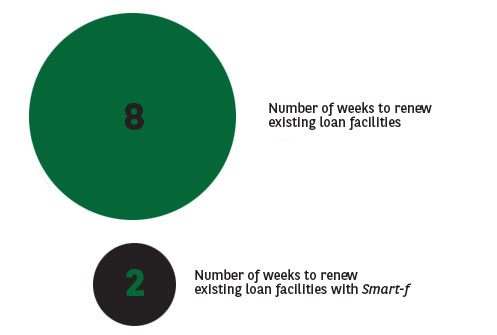Forty hours of meetings, dozens of phone calls,
hundreds of emails, piles and piles of paper: one of the more onerous tasks
CFOs and corporate treasurers must perform is to manage the renewal of loans with
its multiple banking partners.
For corporates, many vital hours of manual processing
go into ensuring the smooth completion of loan transactions across many banks.
From inception, renewals of existing loan facilities can take up to eight weeks
to complete, which is a significant administrative burden.
What if this eight-week lead period could be reduced
to two weeks? This is what Smart-f, a new platform under development in BNP
Paribas’ Financing Solutions division, is aiming to achieve, with support from
the bank’s Innovation unit. It is a co-creation process that tears up the
rulebook: in an age of disruption, how should firms partner with clients and
other stakeholders to harness the power of new technologies? How can firms put
themselves on a firmer footing for longer-term, sustainable growth?
21st century corporates
Guillaume Lemarchand, Chief of Staff in Financing Solutions, explains how the venture got off the ground: “The Smart-f project began with a team of Financing Solutions volunteers formalising a ‘workshop idea’. Our initiative was then selected by the bank’s CIB Innovation Factory unit, whose aim is to pick out the best, most original ideas for development. The project was then incubated at the CIB Fab Lab, an internal workshop that facilitated our partnership with IT colleagues in agile mode, interacting with coverage bankers and clients along the way.”The combination of an established mode of working and human behavioural inertia can often conspire to keep innovation at bay: recognition of this is the first, vital step.
Client input is central to the mission: try as banks might, they can only fully appreciate the challenges clients face by brainstorming with them. Inviting them to contribute their ideas gives the project a much better chance of avoiding blind spots and of optimising of the end-user experience. Nurtured by a group of financial solution innovators, taking a project like this from the bottom-up is one of the key characteristics of co-creation.
Loan syndication, revisited
The Smart-f platform will consist of two separate services: first, it will digitise the current client process of selecting arranging banks, replacing the burdensome paperwork that has hitherto governed the selection; second, if BNP Paribas is selected as one of the lead arrangers, the bank will invite all participating banks into the deal, automatically generating all the necessary documentation. The borrower is able to follow each step of the process in a fully transparent way. Today, the application works on established LMA (Loan Market Association) documentation standards, but next-stage developments will include the loading of custom documentation and electronic signatures.
Smart-f’s benefits should be extensive: a significant reduction in time and human resources, a significant increase in productivity and efficiency, and much greater control over the monitoring of the loan syndication process, in real time. Corporate CFOs will have a better structure, easier selection of their banking partners, and the facility to generate and execute legal documentation with much greater ease than before.
Technology × Co-creation = Smart Working
The immense possibilities opened up by rapid change in technology, in artificial intelligence and in big data underline how banks must move to much more agile modes of working. Tasks hitherto considered repetitive and manual are painful because they were conceived when technological constraints were much greater. However, the combination of an established mode of working and human behavioural inertia can often conspire to keep innovation at bay: recognition of this is the first, vital step.Yet technology is only one part of the equation: getting the best out of new technology means working in partnership with all stakeholders, setting up new dynamic processes to draw on their vast reserves of creative talent to co-design and co-create lasting solutions. Smart-f is about applying smart thinking to allow us to work smarter.
For banks in the 21st century, to do nothing is not an option; to innovate and break new ground is perhaps the only option.

